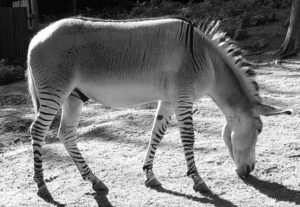By Dr. Don Bierle, President
I recall many exchanges of jokes that began with “What do you get when…” For example: What do you get when you cross a cow and a trampoline? Answer: A milkshake!
When this question is applied to nature, you often get a “real” answer.

What do you get when you cross a zebra with a horse? A “zorse” of course! What do you get when you cross a camel and llama? A “cama”! Lions and tigers produce “tigons” and “ligers.” This actual phenomenon of hybridization among animals and plants, even at the higher biological classification of genus and family, is challenging evolutionary theory today.
First, it blurs the foundational evolutionary concept of “speciation.” The theory is that over millions of years, genetic diversity arose spontaneously to form a single “tree of life” – from single cells to humans. As new species arose on branches of the tree, they lost their ability to produce hybrids with the species from which they arose. That’s why they are classified as a separate species. New techniques of DNA analysis, however, have led to the discovery that organisms above the species level, at the genus or even family classification, are often able to hybridize. The illustrations given earlier are examples of this. Finches, tanagers, and sparrows are all separate biological families but are able to hybridize. How can their genetic compatibility be explained?
Second, widespread hybridization calls into question the evolutionary single “tree of life” itself. The assumption has been that the diversity of life arose over billions of years from an original single-celled ancestor. The hierarchy of life allegedly separated over time into independent branches of the single tree that are incapable of interbreeding (hybridization). That is not what biology is discovering about species today.
God made it clear that He created life according to “kinds” (Genesis 1:12, 21, etc.). This is also the classification identified with the animals that boarded the Ark (Genesis 6:19-20). Creationists study living things in a unique approach called baraminology, the study of biblical kinds. Instead of a single tree of life, creationists think of an orchard. Each tree in the orchard with its many branches represents a biblical kind: a designed and unique “toolbox” containing immense genetic diversity and potential in order to respond to environmental challenges and create new species rapidly.
That’s why plants and animals within each “family tree” of the orchard have genetic compatibility and are capable of hybridization. Current baraminology studies estimate there are about 137 mammal and 196 bird kinds (trees in the orchard). This is why God only had to choose selected animals from each of the trees for the Ark and not all mammal and bird species. Those selected representatives could diversify quickly into the others of their kind after the Flood.

This scientific research of life forms is yielding insight consistent with the Bible’s own testimony about the creation:
“But ask the animals, and they will teach you, or the birds of the air, and they will tell you; or speak to the earth, and it will teach you, or let the fish of the sea inform you. Which of all these does not know that the hand of the Lord has done this? In his hand is the life of every creature and the breath of all mankind.” Job 12:7-10 (Cf. Romans 1:18-20)
A “pizzly”? That’s a cub from polar bear and grizzly parents. That’s funny!
Source: Answers Magazine, Vol. 12, No. 6, pp. 54-62. “The Great Species Mixup” by Tom Hennigan


